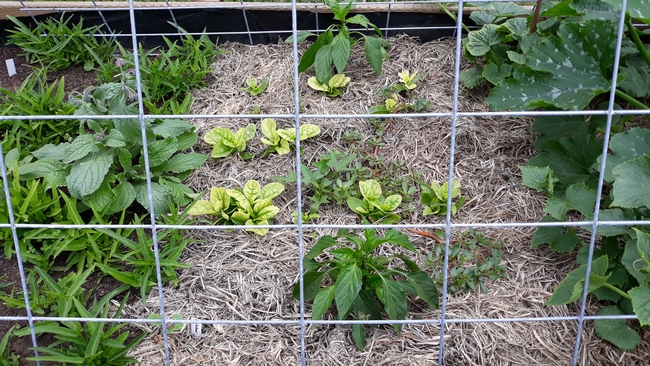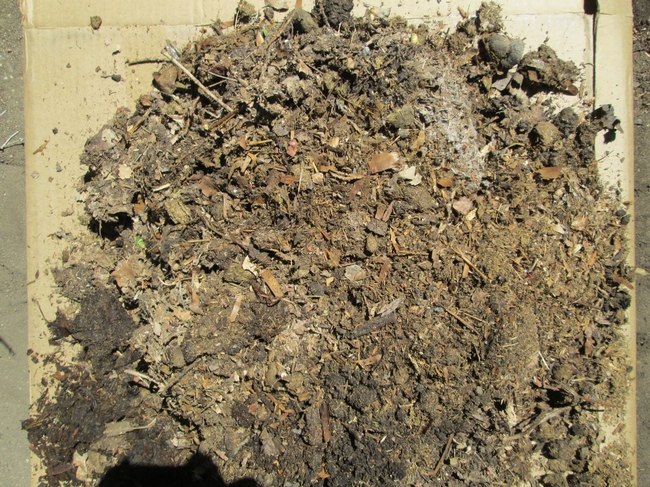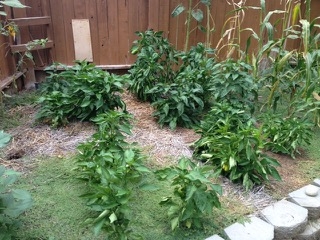- Author: Sheri Pueblo
A Living Mulch vs a Traditional Mulch Approach
Adding mulch to a garden is an efficient and easy way to improve your garden's quality and drought tolerance in our dry hot summers with low precipitation. Benefits of mulch include helping to prevent excessive evaporation and dryness by holding and maintaining moisture, keeping the soil underneath cooler for beneficial organisms, and reducing weed growth.
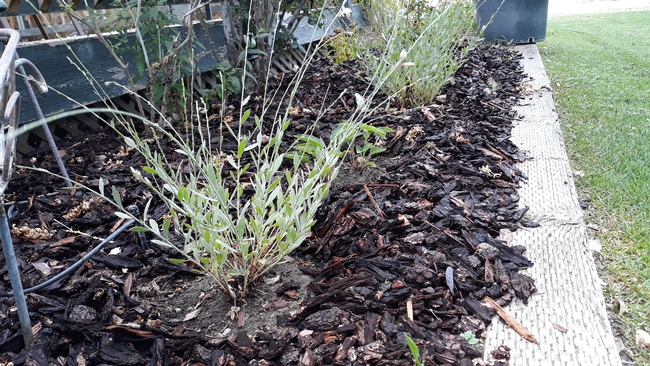
When spreading mulch material such as straw or wood chips, use a depth of 2-3 inches over the soil but keep a clear perimeter of 4 inches around the base of the plant so that the mulch won't rot or mold at the crown and possibly introduce disease. You may want to compost or fertilize the soil with slow release nutrients per treatment recommendations and water in prior to mulching.
A “living mulch” involves growing “fill in” plants either as a ground cover, cover crop or low growing plants that provide several purposes. A mixture of plants can grow longer depending on seasonal and zone (USDA or Sunset™)appropriate plant choices which can promote the overall health of the soil.
Plants produce sugars through photosynthesis and small amounts of these exude from the roots back into the soil. This process draws and concentrates microbes around the roots providing better access to nutrition for the plant, and can also improve soil structure and ability for rain permeation, deeper root growth, better water holding capacity, nutrient forming capacity and hummus formation, all which contribute to overall healthier long term soil building.
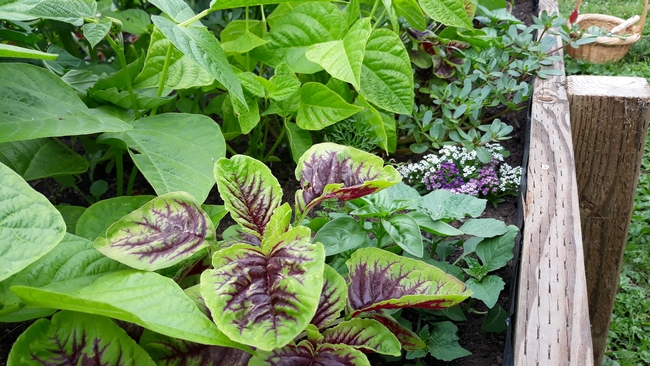
Of course weeds are weeds and you may still have to do some pulling, especially before they go to seed. However there should be much less weeding and you will have a nice variety of plants, edibles, soil builders and color.
You can find out more on several You Tube videos about living mulches if you're interested, but remember to use plants appropriate for the Great Basin and not coastal California for the best success.
If you have questions about mulch, living or otherwise, please contact our helpline at immg@ucanr.edu.
- Author: Alison Collin
In the last few years there has been an interest in “no till” methods of gardening that propose numerous benefits such as increased yields, less physical work, and much healthier soil cited as reasons we should stop digging our soils. However I wonder if this method of growing is really suited to the environs of desert areas? Here are some thoughts of mine on the issue.
Let's start with what “no till” growing is, and how does one go about doing it.
There is more than one way to accomplish a "no-till" garden but the most commonly advocated method is sheet mulching. (It goes by many names.) As the name suggests, the soil is not dug in preparation for growing food or ornamental plants but rather the top of the soil is regularly amended with organic matter which works its way down into the soil to feed the roots of the plants from above. To start a new growing bed using this method, a layer of cardboard is put over the surface of the ground in order to suppress existing weeds. Then a deep layer of well-rotted compost is laid over the top and crops are grown in this. Plants are mulched to retain moisture, and over time the cardboard rots and worms take the compost down into the native soil. This is considered to be closer to how plants and soils interact in the natural world.
By contrast, hand digging or rototilling disturbs the natural profile of the soil by destroying earthworm burrows and bringing the natural and beneficial mycorrhizae to the surface where ultraviolet light and drying conditions kill these fungi. It also interferes with the natural drainage of soil so dug soils drain poorly compared to the compost in no till beds and soil loss by wind erosion is increased.
There is a lot to be said in favor of the no till method. However, is a no-till method like sheet mulching suitable for desert situations with a very low natural rainfall? Most of those who advocate this method of growing and have the greatest success live in high rainfall areas where precipitation is regular throughout the year, and often the rainfall each month is as much as our desert area receives in a year! We also have very dry air with a relative humidity often less than 10%, with frequent, quite strong, drying winds. Our natural vegetation is sparse and prickly as a result of the climate, and things decompose very slowly.
Beneficial to the soil as “no till” might be, some arguments in favor do not hold up in our area. Supposedly it is less labor intensive since one does not dig, but to produce the amounts of compost needed in our area for this method to work, one either has to constantly turn compost heaps, or else buy compost in bulk (assuming that you can find a local source), pay for it to be delivered and then barrow it to the growing area! Our environment makes it hard to even acquire something to make compost from in sufficient amounts.
Then there is the tremendous water usage, both for keeping one's compost heap working and then keeping the applied compost damp enough for these benefits to occur in the garden. Everything dries quickly in our wind, sun, and heat.
Mulch such as wood chips takes a long time to rot down in the desert but without some protection our desert winds can certainly remove loose topsoil. In my experience they are equally efficient at removing the finer particles of mulch, leaving only the sticks behind. Often I have put a deep layer of shredded leaves around plants and on top of the drip irrigation tubing but this fine mulch, far from rotting down or being taken into the soil by accommodating earthworms has rapidly vanished into the next county during our high wind events. This does not happen so much if the mulch surface is kept wet, but can we afford to use that much water when facing a serious drought?
When digging I always incorporate generous amounts of compost or manure or any remaining surface mulch into the ground where it will not get blown away and will be in close proximity to the roots of my crops. I dig in winter when earthworms are very deep in the soil but by spring I have an extremely healthy population.
In many places in the desert where the soils are sandy and alkaline, earthworms are a rarity - if present at all, so in these cases the downward movement of organic matter placed on the surface is not likely to happen for several seasons, and indeed where I have raked several year's accumulation of leaves from under shrubs, even the bottom layer hardly shows any evidence of the leaves breaking down.
No till's proponents admit that slugs and snails are common problems in the compost-grown vegetables, although I doubt whether that would be much of a problem here, but I did mulch heavily with straw one year and consequently had the worst European earwig infestation that I have ever experienced.
Our desert soils certainly need a lot of help in the form of organic matter if they are to produce crops, but it is difficult to know which is the best way to achieve that. As with most horticultural endeavors there are pros and cons to both methods but it pays to think of different options, and perhaps do a trial bed before embarking either method on a large scale.
____
Editor's note: Another consideration is the population of weeds present. At least in the Owens Valley, our perennial weeds, especially Bermudagrass, emerge through the cardboard layer quickly since it is insufficient to stop them. A gardener would have to eliminate perennial weeds first. Our wind also brings in fresh seeds of wind-dispersed annual weeds that grow well in the rich, organic layer.
- Author: Lori Plakos
Conducted by Master Gardener Volunteer, Lori Plakos.
I planted a 10'x10' test garden using different mulches to compare their effect on the production of bell peppers.
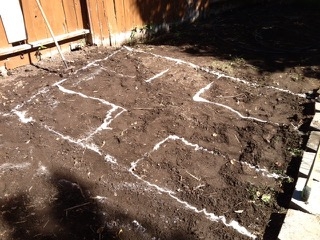
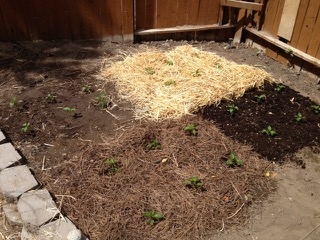
The test crop was bell peppers. Each plot was planted with three specimens each of red and yellow varieties which were purchased from a local nursery. These were planted on April 25, 2013. Unfortunately, the plants were subjected to a heat wave the following week, while I was out of town, and the housesitter had a difficult time keeping the plants moist, with the result that the control plot and the straw plot each lost a plant, and two died in the pine needle section, while those in the vermicompost all survived.
Variables to consider:
- Automatic sprinkler irrigation may have been inconsistent through the bed.
- Proximity to a fence may have influenced sun exposure. The straw and pine needle plants were furthest from the sun protection of the fence.
- Difficulty determining when to harvest. Waiting until peppers changed color appeared to be too late - they often rotted on the plant. I wasn't sure if I should consider all fruit, particularly toward end of season when fruit wasn't completely ripe. I included fruit of a particular size from all plants, even though I personally try to eat only colored peppers that are fully ripe. I know a lot of people eat green peppers.
Observations:
The non-mulched section (5 plants) grew weeds. The largest grasses were removed to prevent spread.
The straw mulch plants (5 plants) had problems with pests, mainly slugs. These were controlled using Sluggo 11. All of the plants had their share of pests, but the straw mulch was the worst. I've read that is a problem possibly due to the less dense nature of the straw harboring the pests. I have used a lot of straw mulch due to the fact it's readily available in my area and economical. I plan on running it through a shredder to make it more compactable and not using it where pests are a concern.
Those mulched with worm compost (6 plants) produced the strongest plants. The nutrients in the vermicompost helped the health of the plants. My preference would be to use that, but it is expensive to be able to use it over large areas. I do a lot of regular composting (mostly grass clippings and leaves), but I worry that working compost that isn't fully composted into the soil will compete with the plants. However, using it as a mulch will allow it to work in the soil over time when it is fully composted and giving the plants nutrients along the way.
The pine needle plants (4 plants) produced the largest crop per plant and overall in spite of the early plant losses and being furthest away from the fence's sun protection.
Results by Total Crop Weight rounding off to the nearest oz.
- Non-mulch: 52 oz.
- Straw mulch: 35 oz.
- Worm compost: 129 oz.
- Pine needles: 161 oz.
Conclusion:
The biggest thing I learned with this test is to MULCH. The most effective thing I learned about mulching during a drought is the resultant reduction in weeding and watering, which is very significant. The less attention you have to give to a particular plant, the more attention you can give to other parts of your garden.
The vermiculture mulch was the most expensive but those plants were the healthiest looking and best grown although they did not produce the heaviest crop. Those under pine needle mulch produced the best yield, far surpassing those grown either under straw or with no mulch at all.
- Author: Dustin Blakey
My family and I just went up Bishop Creek to check out the fall color. You should, too. Its beauty may inspire you enough that you won't mind the drudgery of raking leaves that will be upon us in a few short weeks.
Your trees spend a lot of time gathering nutrients and resources to make leaves, and they're a valuable asset. Maybe not like gold or platinum, but useful anyway.
Leaves are a good way of adding organic matter to a garden or compost pile. You have to do something with them, so why not put them to use after spending all that effort gathering them?
On their own, leaves decompose very slowly. Oaks in particular seem to be in no hurry to break down. In order to speed this process up, the compost pile or garden needs to have adequate nitrogen and moisture available. UC has a couple fact sheets on composting:
- Why Compost?
- Compost in a Hurry (Probably not the most practical system with fall leaves, but good info.)
- SLO Backyard Composting Guide
CalRecycle has information on composting as well. Check out their website.
We tend to be dryer than these other places so our compost needs to be moistened and/or kept covered. Even in winter.
Small particles will decompose more quickly than big ones. I try to grind up my leaves. For everything but my oak tree, I have a leaf blower that reverses direction and turns into a vacuum that sucks and grinds leaves once they're dry. I find that the fastest way. For my oak leaves I have to be more creative...or just patient. It's remarkable how small a leaf pile gets after it has been chopped up.
I incorporate my chopped leaves into my garden and add a little nitrogen and water. By spring they have broken down. I am lucky that I have just the right number of leaves for this to work, but some yards have far too many. Compost piles are a better option in this case.
If you've accumulated pine needles, know that these make an excellent mulch for the landscape. Note that in some communities composting and mulching are frowned upon. Ask your fire department about mulches if you have questions.
We encourage you to make the most of what your landscape gives you. Look into composting yard waste or using it as a mulch.
- Author: Alison Collin
- Remember to winterize irrigation systems before the heavy freezes start. If you have a “frost free” faucet attached to the wall of your house, make sure to disconnect any hoses from it, especially those with a pressure nozzle attached. The mechanism is inside the house wall, and the stretch between the mechanism and the actual faucet is prone to bursting in cold weather if water cannot drain from it. The same applies to “splitters” or Y connectors – either remove completely or make sure that the nozzles are in the open position.
- If you banded trees with Tanglefoot for insect control, remove the bands for the winter.
- Check any plant ties to make sure that they have not become too tight over the summer and loosen or reapply as necessary.
- If you did not harvest bush or climbing beans when fresh, leave them to dry on the vines and then harvest them as dry beans for use in soups. Put them in the freezer for a couple of days after shelling them to kill off any bugs.
- If you are planning to use straw mulch over the winter, make sure that you buy straw and not hay. Hay contains seeds of grasses, oats or alfalfa and although these are nutritious for stock they will rapidly grow in the garden – and who needs all that weeding?



